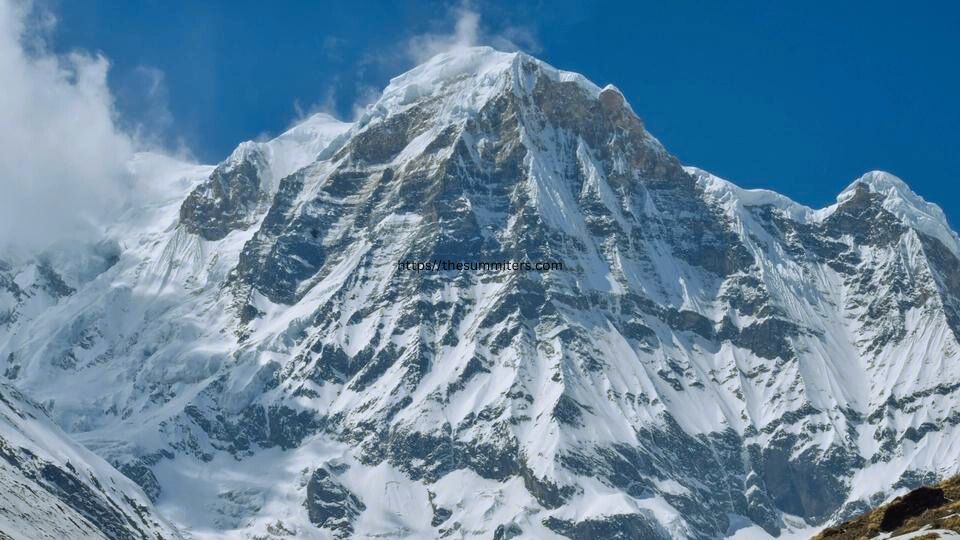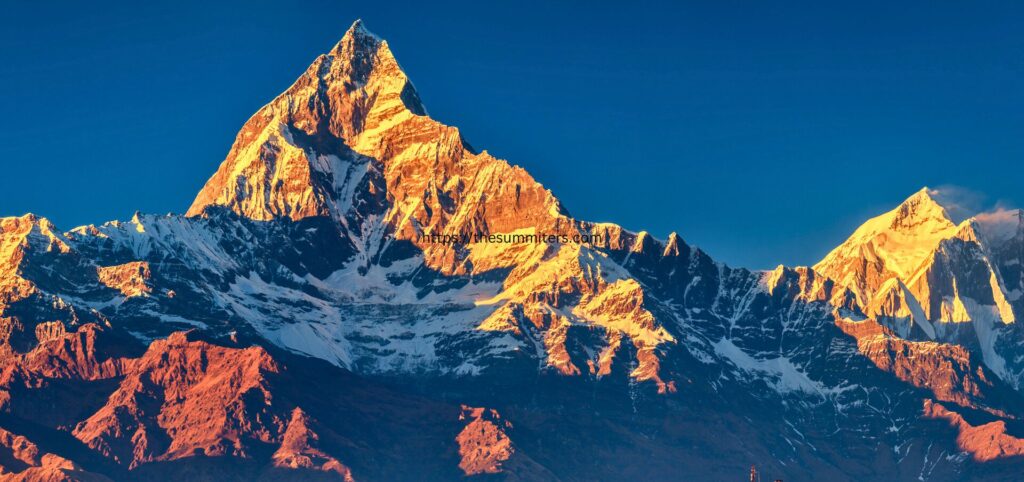In the western part of the colossal Himalayan mountain range, a massif of unparalleled beauty and spiritual significance rises to the sky – Annapurna. Comprising several peaks, with Annapurna I reigning as the 10th highest mountain in the world at 8,091 meters (26,545 feet), this magnificent region is not just a geological wonder but also a cultural and spiritual haven for those who call it home.
Geographical Splendor
Nestled in the heart of the Himalayas Annapurna is like a majestic giant reaching out across Nepal and even stretching into the lands of Tibet. In this mountainous home, Annapurna I stands tall, proudly claiming the title of the main peak, soaring to an impressive height of 8,091 meters 26,545 feet. Imagine it as the 10th highest peak globally, a mountain with its own unique personality. But Annapurna is not a lone ranger; it hosts a family of peaks, each playing its part in creating the breathtaking beauty that defines this region. It’s like a community of majestic neighbors, contributing to the overall splendor that makes Annapurna a truly awe-inspiring place.
Geological Marvels of Annapurna
The Annapurna Massif: A Panorama of Peaks
take it as given the Annapurna massif as a close knit family of peaks each with its distinct personality and story to tell. At the heart of this mountain community is Annapurna 1 the central figure, surrounded by its siblings Annapurna 2,3, and IV, along with other remarkable summits like GangapurnaTilicho Peak, and the mysterious Machapuchare. It’s not just a random collection of peaks. it is a vibrant collection like a group of friends with their own quirks and charms. As you gaze at this breathtaking family representation , it’s easy to see why it captures the hearts of mountaineers trekkers, and nature lovers alike. Each peak adds its unique brushstroke to the panorama, creating a masterpiece that leaves a lasting impression on all who are blessed with good luck enough to witness it.
Geography and Topography: A Diverse Landscape
Imagine Annapurna’s landscape like a living painting, showing off the amazing variety created by Mother Nature. It’s not just a piece of land it’s a vibrant display of nature’s wonders. Picture strolling through green valleys that feel like a cozy hug. The fields look like patchwork quilts, each telling a story of hard work and care. Then, the scenery changes to vast high-altitude deserts, simple yet stunning in their raw beauty. It’s like a treat for the eyes if you’re fortunate enough to explore this fantastic area.
Now, let’s chat about the protector of this natural masterpiece – the Annapurna Conservation Area. Think of it as a devoted caretaker, making sure the diverse ecosystem stays healthy. Stretching across the land like a big hug, it’s one of Nepal’s biggest protected areas. Inside its borders, different ecosystems peacefully coexist, adding to the lively mix of life that makes the region so special. It’s not just about saving the land; it’s about keeping the delicate balance that allows this living artwork to thrive.
Annapurna in Hindu Mythology – The Goddess of Nourishment
In Hinduism, Annapurna is like a revered goddess, and her name carries a lot of meaning. “Anna” means food or grains, and “Purna” means fullness or completeness. According to a story passed down through generations, Annapurna appeared with a purpose – to help people who were hungry and make sure there was plenty for everyone in the world.

In Hindu stories Annapurna is closely connected to Lord Shiva who is a really important god. There’s a captivating tale that tells us how Annapurna, out of kindness and generosity, once set up a kitchen to feed people who didn’t have enough to eat. To test how devoted she was, Lord Shiva, in disguise, went to her kitchen. When he saw the goddess’s selfless actions, he praised Annapurna, recognizing her as the kind deity who tirelessly provides nourishment to the whole universe. This story paints a picture of divine kindness and shows the strong connection between Annapurna and Lord Shiva in the rich tapestry of Hindu beliefs.Mythical Tales of Annapurna and Lord Shiva
Annapurna is often associated with Lord Shiva, one of the principal deities in Hinduism. A captivating myth recounts how Annapurna, in a display of her compassion and generosity, once set up a kitchen to feed the hungry. Lord Shiva, in disguise, came to test her devotion. Upon recognizing her, he praised Annapurna for her selfless act and acknowledged her as the goddess who provides sustenance to the universe.
The Annapurna Circuit: A Trekker’s Paradise
found on the Annapurna Circuit is like entering a paradise for people who love trekking. This famous path goes all around the massive Annapurna mountain attracting adventurers who want both exciting experiences and a chance to learn about different cultures. As you walk along this route you’ll go through a variety of beautiful landscapes, from fields with steps like stairs and dense forests of rhododendron flowers to high deserts with snow on top of the mountains.
While on this journey trekkers will get to meet people from different cultures as they go through charming villages like Manang and Pisang. These villages have been around for a long time and have a mix of traditions and customs mainly from the Gurung and Thakali ethnic groups. The locals are really friendly and happy to show visitors what their everyday life is like along with their unique customs and traditions that have been around for a very long time. And to make the trek even more special there are monasteries and shrines all along the path, giving it a deep and spiritual feeling.
Balancing Tourism and Conservation
With an increasing number of people exploring the Annapurna region, a big challenge pops up — how to welcome tourists while also taking good care of the environment. To make sure the area’s natural beauty and cultural history stay just as special, we need to use sustainable practices. This includes working hard to limit how many visitors come, being responsible with waste, and promoting trekking in ways that are good for the environment.
Guiding the Path for Thoughtful Travel
Ever since they declared it a conservation area in 1986, the Annapurna region has been a leader in showing us how to travel in a way that’s good for the environment. The Annapurna Conservation Area Project ACAP is all about saving the variety of life, helping communities grow, and promoting travel that’s mindful of nature. People in the local communities are actively involved in making sure special plants and animals in the area are protected, all while making sure everyone who lives there is doing well..
Beyond Trekking – Exploring Annapurna’s Hidden Gems
Tilicho Lake: The Highest Lake in the World
Snuggled in the Annapurna mountains, Tilicho Lake is like a hidden treasure that draws trekkers looking for a bit of excitement. Sitting way up high at 4,919 meters (16,138 feet), this mountain lake is a calm and reflective spot in the middle of the wild and rough landscape.
Machapuchare: The Fishtail Mountain’s Enigma
Rising proudly in the distance with its distinct fishtail-shaped summit, Machapuchare is a sacred mountain that people haven’t climbed as a sign of respect for the local beliefs. Its natural beauty and unique shape create a captivating scene that trekkers and climbers find truly enchanting.

Cultural Significance
The name Annapurna comes from Sanskrit, where (Anna) means food or grains, and “Purna” means full or complete. Annapurna is like a respected goddess known for providing food to the whole world. Many Himalayan communities believe her blessings are really important for a good harvest and everyone’s well-being.
Legend has it that Annapurna once pretended to be a poor woman and set up a kitchen to feed people who needed it. Her partner, Lord Shiva, came in disguise to test how generous she was. When he realized it was her, he praised her for being so devoted to feeding everyone. This story shows how caring Annapurna is and how crucial she is in making sure all living beings are well.
Trekking and Adventure
Besides being a significant place for religion and culture, the Annapurna region has become like a dream come true for people who enjoy trekking and adventure. The Annapurna Circuit, a beloved trekking path, offers amazing views of the massive Annapurna, delightful villages, and a mix of landscapes from lush forests to dry, high-up areas.
While walking through traditional villages, trekkers get to experience a special mix of local cultures, traditions, and friendly hospitality. The different plants and animals in the region also catch attention, making it a unique place known as a conservation area.
Challenges and Conservation
While the Annapurna region is fascinating, it deals with challenges in caring for the environment and making tourism eco-friendly. Folks are putting in a lot of effort to figure out how to let visitors enjoy the beauty without harming the delicate ecosystems. Conservation projects are in place to protect the different kinds of wildlife, maintain the trekking paths, and promote responsible ways for tourists to explore.
Resource: Wikipedia
Read Also: Another Setback on Annapurna